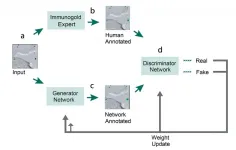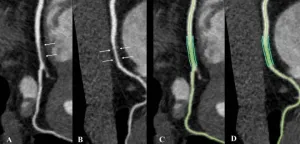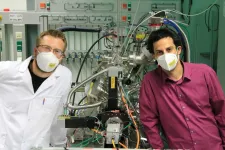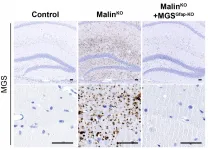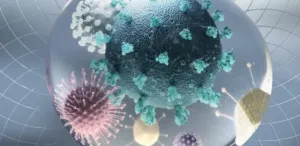(Press-News.org) UNIVERSITY PARK, Pa. -- Have you recently turned to your mobile device or computer to find out if your cough, sniffle or fever could be caused by COVID-19?
The online symptom checker you used may have advised you to stay home and call your medical provider if symptoms worsen, or perhaps told you that you may be eligible for COVID-19 testing. But why did it make the recommendation it did? And how should you know if you can trust it?
Those are questions that researchers at the Penn State College of Information Sciences and Technology recently explored through a project in which they augmented online symptom checkers by offering explanations of how the system generated its probable diagnoses and suggestions -- while also studying users' perceptions of those recommendations.
"People are confused about why online symptom checkers ask certain questions and how they make certain recommendations and decisions," said Chun-Hua Tsai, assistant research professor and first author on the research paper. "These interactions are not very transparent, which is OK if you just have a common cold, but with COVID it could be pretty serious."
Tsai explained that current online symptom checkers, which are powered by machine learning algorithms, use information that users provide to guide the checker in its next steps toward a possible diagnosis. However, the AI-driven systems' lack of transparency and comprehensible language could result in unintended -- and potentially tragic -- consequences if a user does not fully understand the recommendations it provides.
For example, if an online symptom checker simply recommended that a user get tested for COVID-19 based on the user's input, it could cause undue worry or unnecessary trips to a medical facility. Conversely, if a user learned from an online symptom checker that they could possibly have the coronavirus, it could lead them to make a poor medical decision such as taking medication on their own instead of being tested or seeking proper medical treatment.
"Explanation in medical diagnosis interactions emphasizes the importance of pragmatics," said Jack Carroll, distinguished professor of information sciences and technology and one of the research paper's authors.
The team's work has potential application beyond COVID-19, said Xinning Gui, assistant professor of information sciences and technology and another collaborator on the project.
"Even before COVID-19, tens of millions of people have used symptom checkers to self-diagnose or self-triage for numerous health conditions," she said. "However, little attention is paid to critical issues such as legitimacy, safety, trust and transparency from a user's perspective. Our work is just the start to fill this gap."
In their work, the researchers reproduced a user's interaction with an online symptom checker and added explanations for why the chatbot asked certain questions and how the recommendations were generated -- for example, if the suggestion was drawn from Centers for Disease Control and Prevention guidelines.
"Based on these explanations, our findings showed that the users were more confident (in the accuracy of the symptom checker) when they received these recommendations," said Tsai. "Transparent symptom checkers could be really useful for people to understand their own situation to make a better medical decision. Potentially, this could [also] be a tool to use in responding to the pandemic public health crisis that we're facing today."
In their study, the researchers interviewed users of online symptom checkers to understand if explanations would improve their user experience and their trust in the online tools. The interviews yielded that users are often confused by the questions that chatbots ask and which symptoms and information led to the suggested diagnosis and advice.
"For the possible causes listed to me, (the chatbot) doesn't tell me why my symptoms have a match. It just says something in a statistical way, like how many people might have this cause. I think the app should show the relations, like explain why it thinks this might be a possible cause, which question it asked, and which answers I gave have led me to this diagnosis," said one survey participant, as published in the research paper.
Then, the researchers designed a COVID-19 online symptom checker to include three types of explanation styles: rationale-based, providing an explanation after each question the system promoted to the user; feature-based, offering a personalized summary based on the user's answers; and example-based, highlighting an identical example of a patient who received the same clinical recommendation as the user based on identical answers.
They found that the explanations not only could significantly improve the user experience, but also could facilitate medical decision-making and improve user trust in the diagnosis.
"Explanation could empower health consumers to make informed decisions," said Gui. "Without explanation about how the symptom checkers come to the results and the underpinning evidence, health consumers will face challenges in comprehending or trusting the diagnostic results."
She added, "Our study proves that providing suitable explanations can help users better interpret the results and make informed decisions."
The researchers' findings could inform future design of online symptom checkers, helping users to potentially navigate a number of medical issues beyond COVID-19.
"Our findings could advance the research area of health recommender systems and explainable AI [artificial intelligence] in terms of personal health care, fairness and user trust," said Tsai.
INFORMATION:
Additional collaborators include Yue You, doctoral student of information sciences and technology; and Yubo Kou, assistant professor of information sciences and technology.
The researchers will present their findings at the virtual 2021 ACM CHI Conference on Human Factors in Computing Systems -- the premier international conference of Human-Computer Interaction -- in May. The work was funded by a seed grant award from the College of IST.
From sample preparation to image acquisition, electron microscopy (EM) requires precise and time-consuming steps to produce the clarity and detail needed to visualize small cell structures with high resolution. Moreover, once EM images are created, extracting the biological information out of them through analysis can be an even more laborious and time intensive task. Especially because current EM analysis software often requires the skilled eye of a scientist to manually review hundreds of images.
With a bit of ingenuity and the application of cutting-edge neural networks, an interdisciplinary team of scientists at the Max Planck Florida Institute for Neuroscience (MPFI) have created a new ...
OAK BROOK, Ill. - People living with human immunodeficiency virus (HIV) and without known cardiovascular disease have two to three times the noncalcified coronary plaque burden of non-HIV healthy volunteers, according to a study from Canada published in Radiology. Researchers said the results underscore the importance of a heart-healthy lifestyle in people living with HIV.
HIV/AIDS emerged as a major public health crisis in the 1980s. Disease-related mortality peaked in the mid-1990s and has been dropping since, thanks in large part to antiretroviral therapy, which does not cure the disease but helps control it.
Today, people ...
Researchers at Beam Therapeutics have developed a redesigned base editor that shows considerable promise in directly repairing the single-base mutation that causes sickle-cell disease (SCD). Many strategies are being pursued to harness genome editing approaches including CRISPR to treat patients with SCD and related hemoglobinopathies. The most advanced method in the clinic involves targeting an upstream regulatory pathway to switch on expression of the fetal hemoglobin gene but does not target the SCD mutation directly.
Writing in the April issue of The CRISPR Journal, a team at Beam Therapeutics, led by Ian Slaymaker and Giuseppe Ciaramella, describe the successful ...
In a study conducted at the University of Helsinki, researchers found a cause for severe epilepsy resulting in death in Parson Russell Terrier puppies at a few months of age. A change in the PITRM1 gene can lead to a dysfunction of mitochondria, the cellular energy pumps. Concurrently, amyloid-β accumulation and widespread neurodegeneration associated with Alzheimer's disease were identified in the puppies' brains. Changes to the PITRM1 gene in humans also cause a severe but slowly progressing brain disease.
Some Parson Russell Terrier puppies were seen to suddenly develop epileptic seizures at 6 to 12 weeks of age. The disease progressed very rapidly, in a matter of hours in the worst cases, to a situation where the seizures were continuous and unresponsive to medication.
"All ...
Exposure to certain endocrine-disrupting chemicals could elevate the risk of breast cancer, according to a new comprehensive systematic review of epidemiological research. However, for many chemicals, evidence is inconsistent or still limited. The review was carried out by researchers at the universities of Hong Kong and Eastern Finland and published in Critical Reviews in Food Science and Nutrition.
Endocrine-disrupting chemicals (EDCs) can interfere with the body's hormonal system, also called the endocrine system, and are widely present in the environment. They originate from a variety of ...
If the CO2 content of the atmosphere is not to increase any further, carbon dioxide must be converted into something else. However, as CO2 is a very stable molecule, this can only be done with the help of special catalysts. The main problem with such catalysts has so far been their lack of stability: after a certain time, many materials lose their catalytic properties.
At TU Wien, research is being conducted on a special class of minerals - the perovskites, which have so far been used for solar cells, as anode materials or electronic components rather than for their catalytic properties. Now scientists at TU Wien have succeeded in producing a special perovskite that is excellently suited as ...
As we accumulate more and more gene-sequencing information, cell-type databases are growing in both size and complexity. There is a need to understand where different types of cells are located in the body, and to map their gene expression patterns into specific locations in tissues and organs. For example, a gene can be actively expressed in one cell while suppressed in another.
One way of mapping genes into tissues is a technique called in situ hybridization. Simply put, a target gene is tagged ("hybridized") with a fluorescent marker within the sections of the tissue it is located in (the "in situ" part). The sections are then visualized under a specialized microscope to see where the gene "lights up". Consecutive photographs of each section are then put together to generate a ...
Lafora disease is an inherited neurodegenerative condition that initially develops with seizures in adolescence and evolves with progressive degeneration of the nervous system to death, about ten years after its onset. It is characterised by the accumulation of abnormal glycogen aggregates called Lafora bodies in the brain. There is currently no treatment for this condition, although some therapies are being tested in clinical trials.
Led by Dr. Joan Guinovart, emeritus professor of the University of Barcelona (UB) and also group leader of CIBERDEM, the Metabolic Engineering lab at IRB Barcelona has discovered that Lafora bodies that accumulate in glial cells, which are essential for the proper ...
You can lubricate a bicycle chain with oil, but what do you do with a Mars rover or a red-hot conveyor belt in the steel industry? Very special nanomaterials have now been studied by the TU Wien together with research groups from Saarbrücken (Germany), Purdue University in the USA and the Universidad de Chile (Santiago, Chile).
The material class of MXenes (pronounced "maxene") has caused quite a stir in recent years in connection with novel battery technologies. But it now turns out that they are also an excellent solid lubricant that is extremely durable and performs its task even under the most difficult conditions. These remarkable properties of MXenes have now been published in the renowned journal ACS Nano.
Like a stack of sheets of paper
Just ...
A new type of COVID-19 testing strategy could help streamline the process of identifying cases, tracking variants and detecting co-infecting viruses.
At present, separate assays and complex workflows are involved in each of these three diagnostic procedures, with analyses typically performed in highly specialized facilities. KAUST researchers have now combined all three kinds of tests into a single procedure that should allow for point-of-care tracking of COVID-19 and the many emerging variants of SARS-CoV-2.
"Our all-in-one test provides a promising integrated solution for rapid field-deployable detection and mutational surveillance of pandemic viruses," says stem cell biologist Mo Li, who led the study.
The test involves a portable ...
